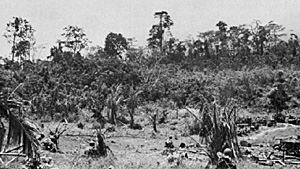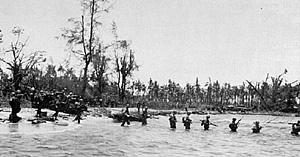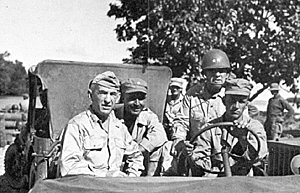The Airfield and the Village
During the day the 2d Squadron, 8th, under Maj. Haskett L. Connor, made its way southward along a native track toward Number 1 Road. Tractors borrowed from the artillery towed supplies and ammunition. Japanese riflemen harassed the soldiers as they toiled slowly upward over a continuous succession of ridges. It was 1500 before F Troop, in the lead, reached Number 1 Road, where it ran into fire from three Japanese positions which covered the track's junction with the road. Enemy mortars to the south added their fire, and Connor decided to dig in for the night. At his request the 61st Field Artillery Battalion silenced the enemy temporarily while the squadron established night defenses about six hundred yards from the road.
The next morning, 16 March, General Mudge and Colonel Bradley visited the squadron and observed its attack which, supported by one light and two medium tanks, overran the positions and enabled Connor's squadron to move east along Number 1 Road. The tanks had been hauled through the jungle with the aid of a D-7 bulldozer which cut down grades, cleared undergrowth, and towed the tanks when they stuck. One tank and the bulldozer remained attached to the 2d Squadron on its advance along the road. By late afternoon it had reached a position on the road about a thousand yards west-northwest of Lorengau village and eight hundred yards south of the airstrip.
The chief obstacle to the 2d Squadron's advance was terrain. The 1st Squadron (less C Troop) had had to fight its way along the coast on Number 3 Road. After landing on the morning of 15 March, the 1st, under Maj. Moyers S. Shore, had started east along the road behind A Troop. The road led through heavy rain forest interspersed with mangrove swamp on low ground. "The recent rains had softened the red clay until it assumed a glue-like consistence which made the footing difficult and slowed leading elements." (Ibid., p. 6.)
About one mile out of Lugos A Troop was halted by three pillboxes. (1st Cavalry Division reports and journals use the word "bunker" for almost every enemy position encountered. Japanese positions along the road and at Lorengau appear to have been, according to World War II terminology, earth-and-log pillboxes.)
With the beach on one side and mangrove swamp on the other, there was no space for maneuver. Without orders from the troop commander one squad attempted an unsupported frontal assault which failed. Major Shore then alerted B Troop to pass through A and assault upon completion of an artillery preparation. From Hauwei 105's of the 271st Field Artillery Battalion swept the enemy area with shells that burst as close as a hundred yards from the cavalrymen. B Troop attacked but was quickly halted.
Shore then asked for a tank, more artillery fire, and a strike by RAAF P-40's (armed with 500-pound bombs), which had been on station since before H Hour, and arranged for 81-mm. mortar support. "The combination of fire and bombs" turned the trick. They "plowed the position into a mass of craters," and B Troop advanced past "the blasted remains of the pillboxes and scattered parts of their tenacious occupants. . . ." (8th Cav Hist Rpt, Admiralty Campaign, Narrative of Events, P. 7.)
The three pillboxes had apparently constituted the airstrip's western defenses, for when they crumbled the 1st Squadron moved freely down the road. By 1700 it had advanced out of the jungle and held a ridge among the palms overlooking the southwest corner of the airstrip. Two of the squadron had been killed, eleven wounded, in the course of the action. Forty Japanese were reported killed. During the night of 15-16 March Shore's squadron, which C Troop rejoined at 1800 after its relief at the beachhead by the 7th Cavalry, received rifle fire from Japanese in a palm grove between the airfield and the sea.
Next morning, 16 March, Shore decided to hold up his attack while an A Troop platoon went north of the strip to clear out the enemy riflemen and C Troop moved along the south edge of the airdrome to reconnoiter enemy positions there. It was noon before the A Troop platoon accomplished its mission and the 1st Squadron could move.
Meanwhile C Troop, after advancing 200 yards over a series of rolling coconutstudded ridges which lay at right angles to the axis of advance, was halted by machine gun fire from a ridge about 150 yards to its front. The troop commander, Capt. Winthrop B. Avery, emplaced the heavy machine guns and 81-mm. mortars which had been attached from the Weapons Troop and attempted a coordinated attack. One platoon was to make a frontal assault while a second platoon worked around the south flank. The frontal attack failed, but the flanking platoon, commanded by S/Sgt. Ervin M. Gauthreaux, literally gained the top of the enemy positions, threw grenades into two pillboxes, and flushed several Japanese. (Gauthreaux received the Silver Star and a commission as 2d Lieutenant.)
But at this point things went wrong. With the enemy threat removed from his left (north) flank, and aware that C Troop was held up, Shore decided to leave C Troop in place to hold the enemy while the remainder of A Troop followed its other platoon through the palms and squadron Headquarters Troop, B Troop, and elements of D Troop drove down the airdrome on C's left. As B Troop advanced in the open it was struck by fire from the very positions that Gauthreaux' platoon was straddling, whereupon it halted, withdrew, and as it carried its casualties back to safety returned the enemy's fire. But the fire hit Gauthreaux's platoon, and Avery was forced to order him off the Japanese positions. (Tanks had advanced along the north side of the strip but did not fire on the C Troop platoon.)
After four hundred 105-mm. rounds had pounded the enemy position, C Troop attacked frontally while B Troop completed its retirement. But the Japanese still remained in their positions on the ridge and broke up C Troop's attack. By now all elements of the squadron had been committed and the Americans had advanced to about the center of the airstrip.
General Mudge arrived on the scene, inspected the squadron, reconnoitered the front, and decided to relieve the 1st Squadron, 8th, with the 7th Cavalry. During the relief, which was effected about 1600, the 7th Cavalry lost five men killed and fifteen wounded.
 TROOP G, 8TH CAVALRY, NEAR NUMBER 1 ROAD on the west side of the Lorengau River, 18 March 1944.
TROOP G, 8TH CAVALRY, NEAR NUMBER 1 ROAD on the west side of the Lorengau River, 18 March 1944.
With the previous day's experience as a guide, General Mudge and Colonel Finley planned a co-ordinated attack for 17 March. The 7th Cavalry and the 2d Squadron, 8th, were to take the remainder of the airstrip and push on over the Lorengau River to the village. The 1st Squadron, 7th, with squads from the 8th Engineer Squadron attached, was to seize the eastern end of the airdrome while the 2d Squadron, 7th, moved south of the strip to make contact with the 2d Squadron, 8th, and advance to the river on Number 1 Road.
During the night of 16-17 March destroyers and field artillery battalions shelled the Japanese positions, and in the early morning twenty-four 81-mm. mortars, two light tanks, and two 37-mm, antitank guns put their fire on the pillboxes. An 81-mm. mortar of D Troop' 8th, attached to the 7th Cavalry, demolished one pillbox and its .50-caliber and 30-caliber machine guns and crew of fifteen men with a direct hit. When the mortars ceased fire automatic weapons opened up, and the 1st Squadron, 7th, assaulted. At 1033 when our troops came out of their fox-holes there were numerous cries of 'Garry Owen' as the 1st Squadron went into its first action against the Japanese." (7th Cav, Hist Rpt 7th Cav, 2 Mar-18 May 44, Pt. B, p. 11. "Garry Owen" is the 7th's regimental song.)
There was little resistance, since the supporting fires had "practically wiped out all enemy resistance except for necessary mopping up of a few bunkers still remaining intact." (7th Cav, Hist Rpt 7th Cav, 2 Mar-18 MaY 44, Pt. B, p. 11.)
The 1st Squadron, under Maj. James A. Godwin, quickly seized the ridge that had held up Shore's squadron the day before, then encountered another ridge position slightly to the east. After artillery and mortars had pounded it, cavalrymen moved in and occupied it. Flame throwers destroyed the pillboxes that remained in action.
Meanwhile noon found the two inland squadrons in contact with each other. By 1300 all three squadrons were in contact and had resumed the eastward advance. Only a few scattered Japanese opposed the move from the airstrip to the river, but emplaced mines caused some casualties and slowed the advance, so that it was 1599 before the three squadrons pulled up on a ridge on the west bank that overlooked the village. It was too late in the day to attack Lorengau, which the Americans had reason to believe was strongly defended.
The 7th Cavalry's reconnaissance platoon had immediately crossed the river over the sandbar at its mouth, met fire from Japanese positions west of Lorengau, and withdrawn. Landing craft bringing in supplies received fire from the hills above the village. And, on the person of a Japanese officer who died defending the airdrome, the Americans had discovered maps of the defenses of Manus which showed that Lorengau and the road leading overland through the villages of Old Rossum and Rossum were fortified.
 CROSSING THE LORENGAU RIVER over the sandbar at the mouth of the river, 18 March 1944.
CROSSING THE LORENGAU RIVER over the sandbar at the mouth of the river, 18 March 1944.
Lorengau lies in a cup-shaped valley surrounded by 400-foot-high hills. Most of the Japanese defenses faced seaward, although positions also covered the roads leading east, west, and south. As the Lorengau River was about sixty feet wide and ten to twenty feet deep in most places, the 2d Brigade's best approach route led over the alluvial sandbar at the mouth. The enemy had planted mines, controlled by a master switch in a pillbox on the hillside, on the stretch of beach between the sandbar and the hills. They had put foxholes and machine gun emplacements about a hundred yards inland from the shore, and had built about twelve pillboxes in the hills. The attackers would have to cross the river and the beach in full view of the enemy positions, but two factors favored an assault: repeated bombings and shellings had uncovered several Japanese positions so that they were visible, and the ridge taken in the 17 March attack provided good observation over Lorengau.
The 2d Squadron, 8th Cavalry, was designated to make the attack with mortar and artillery support. At 1000, 18 March, the reconnaissance platoon led out in single file followed by E, F, and G Troops. The move was unexpectedly easy; only scattered machine gun fire was directed at the reconnaissance platoon, which quickly cleared the beach and the rifle pits. It cut the master cable leading to the mines. Later a dead Japanese was found in a small pillbox with the detonator switch clutched in his hand.
The rifle troops received fire and some casualties while crossing the river, but got over rapidly. On the cast shore they deployed and prepared to attack. E Troop was to assault the enemy center in Lorengau with F Troop echeloned to the right rear; G Troop was to take the hills beside the river. Artillery and 81- mm. mortars hit the enemy once more, and when their fire ceased 60mm.'s and machine guns opened up, whereupon the cavalry troops assaulted the bunkers with grenade, submachine gun, rifle, and flame thrower. Again, it was unexpectedly easy, for the Japanese apparently retreated inland over Number 2 Road (Little is known about Japanese decisions and movements, as no Japanese survived to report to Rabaul. 8th Area Army Operations, Japanese Monogr No. 110 (OCMH), p. 134.)
Eighty-seven Japanese were killed defending Lorengau, while the 2d Squadron, 8th Cavalry, captured it at a cost of seven wounded.
 LT. GEN. WALTER KRUEGER (front seat) with Brig. Gen. William C. Chase and Maj.
Gen. Innis P. Swift on an inspection tour, Los Negros Island.
LT. GEN. WALTER KRUEGER (front seat) with Brig. Gen. William C. Chase and Maj.
Gen. Innis P. Swift on an inspection tour, Los Negros Island.
Fighting in the Admiralties was not yet over; it was 18 May before General Krueger officially terminated the operation. Los Negros was not cleared of the enemy until the end of March, and it took two squadrons, several tanks, P-40 strikes, and a good deal of artillery fire before the 2d Brigade cleared Number 2 Road to Rossum on 25 March. But the capture of Lorengau airfield, following the seizure of Momote, placed in Allied hands the main strategic objectives of the operation. During the entire operation (including the seizure of more outlying islands in April) the 1st Cavalry Division lost 326 men killed, 1,189 wounded, and 4 missing. It reported burying 3,280 and capturing 75 of the enemy, and General Krueger estimated that the Japanese had disposed of 1,100 more bodies. (ALAMO Force Rpt, BREWER Opus, p. 26.)
Base Development
Meanwhile several battalions of Seabees, plus Army engineer units, were building airfields and a naval base. MacArthur, Nimitz, and the Joint Chiefs of Staff had intended that the naval base be used by all Allied fleets serving in the Pacific. In February N Imitz proposed to Admiral King that Admiral Halsey, who furnished most of the service troops, be given responsibility, under Nimitz, for developing and controlling the base. (Rad, CINCPAC to COMINCH, 23 Feb 44, CMIN 16947.)
Nimitz' proposal was rejected by the joint Chiefs but not before MacArthur became so irate that he ordered work on the Admiralties "restricted to facilities for ships under his direct command--the Seventh Fleet and British units." (Halsey and Bryan, Admiral Halsey's Story, p. 189; Rad, Marshall to MacArthur, 9 Mar 44, CMOUT 3710.)
Halsey, whom MacArthur vainly requested as his commander of Allied Naval Forces, made a hurried trip to Brisbane in early March and found that MacArthur "lumped me, Nimitz, King, and the whole Navy in a vicious conspiracy to pare away his authority." (Halsey and Bryan, Admiral Halsey's Story, p. 189; Suppl Min, JCS rntg, 8 Feb 44; Rad, MacArthur to Marshall, 2 Feb 44, CM-IN 1443.)Halsey was in a difficult position. MacArthur was very angry; he was Halsey's superior, and was vastly senior to him. (During World War I MacArthur had commanded a brigade and then a division while Halsey commanded a destroyer.)
And it is probably gratuitous to say MacArthur was formidable in argument. The scene, as Halsey records it, was lively, with MacArthur expressing himself strongly. "Unlike myself," the Admiral wrote, "strong emotion did not make him profane. He did not need to be; profanity would have merely discolored his eloquence." But the ram-jawed Halsey could also be formidable. Supported by Kinkaid and Carney, he asked the General to rescind his order: " . . . 'if you stick to this order of yours, you'll be hampering the war effort."
Halsey went on to say that "the command of Manus didn't matter a whit to me. What did matter was the quick construction of the base. Kenney or an Australian or an enlisted cavalryman could boss it for all I cared, as long as it was ready to handle the fleet when we moved up New Guinea and on toward the Philippines." After long argument, General MacArthur agreed to cancel his order and the work went forward under Admiral Kinkaid's direction. (Halsey and Bryan, Admiral Halsey's Story, pp. 189-90; Oral statement of Adm Kinkaid to the author et al., 16 Nov 53. General Kenney, in his comments, remarked, that Halsey's statement sounds as though "he didn't like me, the Australians, or enlisted cavalrymen." Actually Halsey was probably only listing people unlikely to be directing construction of a naval base.)
Momote airfield, first used in March, was seven thousand feet long by 18 May. When the Lorengau airstrip proved unsuitable, Seabees and the 836th Engineer Aviation Battalion, working under pressure, finished one at Mokerang Plantation by 2 1 April, then put in a parallel runway. Seabees installed two runways for carrier aircraft on the outlying islands, and also developed Seeadler Harbour into one of the largest naval bases in the Pacific, with repair facilities for all types of warships and transports (Building the Navy's Bases in World War II, II, 295-302; Off of Chief Engr, GHQ AFPAC, Airfield and Base Development, pp. 208-22, and Critique, PP. 145-53.)
As planned, the naval base serviced the Third, Fifth, and Seventh Fleets in later operations, and the airfields supported the drives along the New Guinea coast and through the Central Pacific. The gallant action of the 1st Cavalry Division in execution of MacArthur's bold decision thus paid rich dividends.
More Action in the Admiralties
- The Decision
The Reconnaissance in Force
To the Shores of Seeadler Harbour
Lorengau
The Advance East
Jumbo Map: Lugos Mission to Lorengau (very slow: 182K)
Jumbo Map: Los Negros Assault (very slow: 247K)
Jumbo Map: Seeadler Harbor Area (very slow: 262K)
Back to Table of Contents -- Operation Cartwheel
Back to World War Two: US Army List of Issues
Back to MagWeb Magazine List
© Copyright 2002 by Coalition Web, Inc.
This article appears in MagWeb (Magazine Web) on the Internet World Wide Web.
Other military history articles and gaming articles are available at http://www.magweb.com